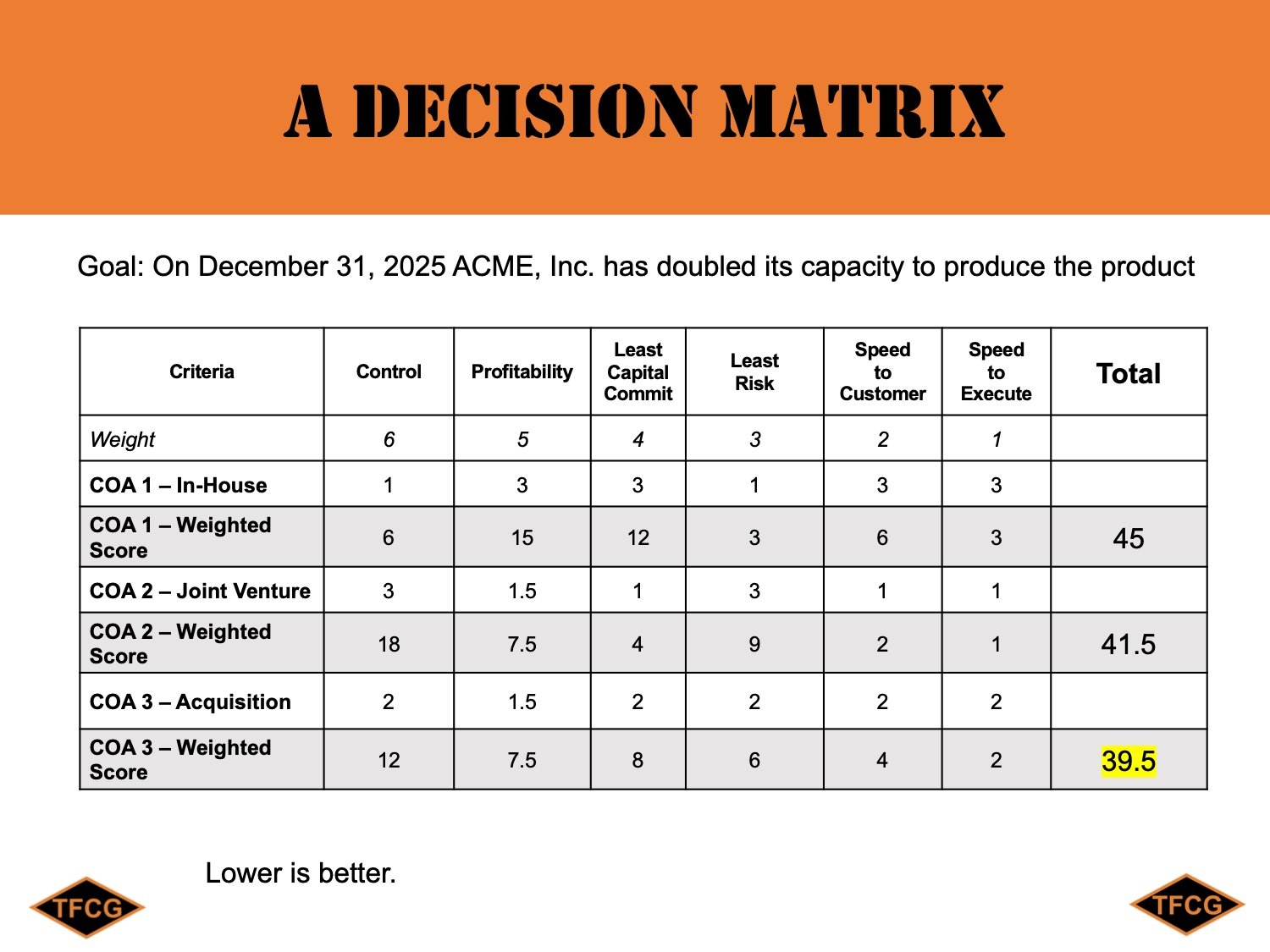Planning — The Decision Matrix (#224)
What tools do you use to help you and your team make decisions? How do you take the emotion out of the decision? Are there tools out there to help you make better decisions?
Intuition, advantages and disadvantages, and the decision matrix are all great tools to use to help you make a better decision in your personal life or in business. The simplest form of decision-making is intuition. Many people and businesses rely on their gut instinct to make decisions. Another tool to help make decisions is to compare the advantages and disadvantages of each solution. It may help to put the advantages and disadvantages for all solutions on one page or on a whiteboard, so it makes it easy to compare and evaluate them.
Decisions, decisions, decisions.
The Decision Matrix
An even better tool for helping make complex decisions is the Decision Matrix, or DECMAT. The Decision Matrix is a tool to evaluate and select the best option between different choices. This tool is particularly useful if you are deciding between more than one option and there are several factors you need to consider in order to make your final decision. There are seven sub-steps to using a decision matrix. There is an example Decision Matrix at the end of sub-step four to help you better understand the process.
To create your decision matrix, follow the seven steps here. To help better understand the process, I will use a hypothetical example of a company (ACME, Inc.) deciding between developing additional capacity by acquiring a company, entering into a joint venture, and building the capability in-house.
1. Identify the solutions that will be compared.
For our example, the solutions that ACME, Inc examined to develop additional capacity were an acquisition of another company (Acquisition), a joint venture with a rival company (Joint Venture), and building the capacity in-house (In-House.)
2. Identify important considerations. Second, identify the important considerations that factor into your decision. This set of criteria helps you identify the best decision and avoid subjectivity.
Continuing the example, the team decided that the most important criterium to factor in when developing additional capacity are control, profitability, least amount of capital commitment, least amount of risk to the business, speed to the customer, and speed of execution.
3. Create your decision matrix. A decision matrix is a grid where you can compare important considerations between the various options. Write the solutions to be compared down the left-hand side of the grid. Write the important criteria across the top of the grid. Determine whether lower is better or higher is better. It is easier to think about lower is better, so you can rank order things as 1 (best), 2 (middle), and 3 (worst).
4. Evaluate the solutions against the criteria. It is easiest to rank the three solutions with 1 being best and 3 being worse.
In the example when compared against control In-House was the best and ranked 1, Joint Venture was in the worst and ranked 3, and Acquisition was in the middle and ranked 2.
5. Add weight. Sometimes, there are certain considerations that are more important than others. In such a case, use a weighted decision matrix to identify the best option for you. To add weight to a decision matrix, assign a number to each criterion. Later in the decision-making process, you’ll multiply the weighting factor by each consideration.
To continue the example, imagine that control is the most important criteria out of the 6 criteria used to evaluate the options. You would weight it with a 6. In the same example, speed of execution is the least important criteria out of the 6 criteria employed. You would weight it with a 1. You would weight the other 4 criteria based on importance.
6. Multiply. Multiply the evaluation of each column times the weight of the column.
Using the example, control was weighted 6. In-House was the best or 1, so 1x6 = 6. Acquisition was in the middle or 2, so 2x6 = 12. Finally, Joint Venture was the worst or 3, so 3x6 = 18. Continue multiplying the other 5 columns.
7. Calculate the total score. Now that you’ve multiplied the weighted scores, add up all of the outcomes for each solution. At this point, you should have a clear, numbers-based answer to which decision is the best one. The number-based answer helps to remove the emotion from the decision.
Continuing using the example, In-House totaled 45, Joint Venture totaled 41.5, and the Acquisition totaled 39.5. Since lower is better, the Acquisition become the recommended solution for the company to develop additional capacity.
Conclusion
Liked this article? Want more on planning and decision making? Then check out:
Planning -- Asking the Right Question
If you’d like some more ideas on how to improve your planning take a look at Chapters 13 and 14 in my book, Grow Your Grit, available for sale at Amazon. Or reach out to me here to start the discussion about getting some help developing a decision making and planning process for your team.
Use the Decision Matrix as a tool to go on the offense and make better decisions for you and your team in 2022.



